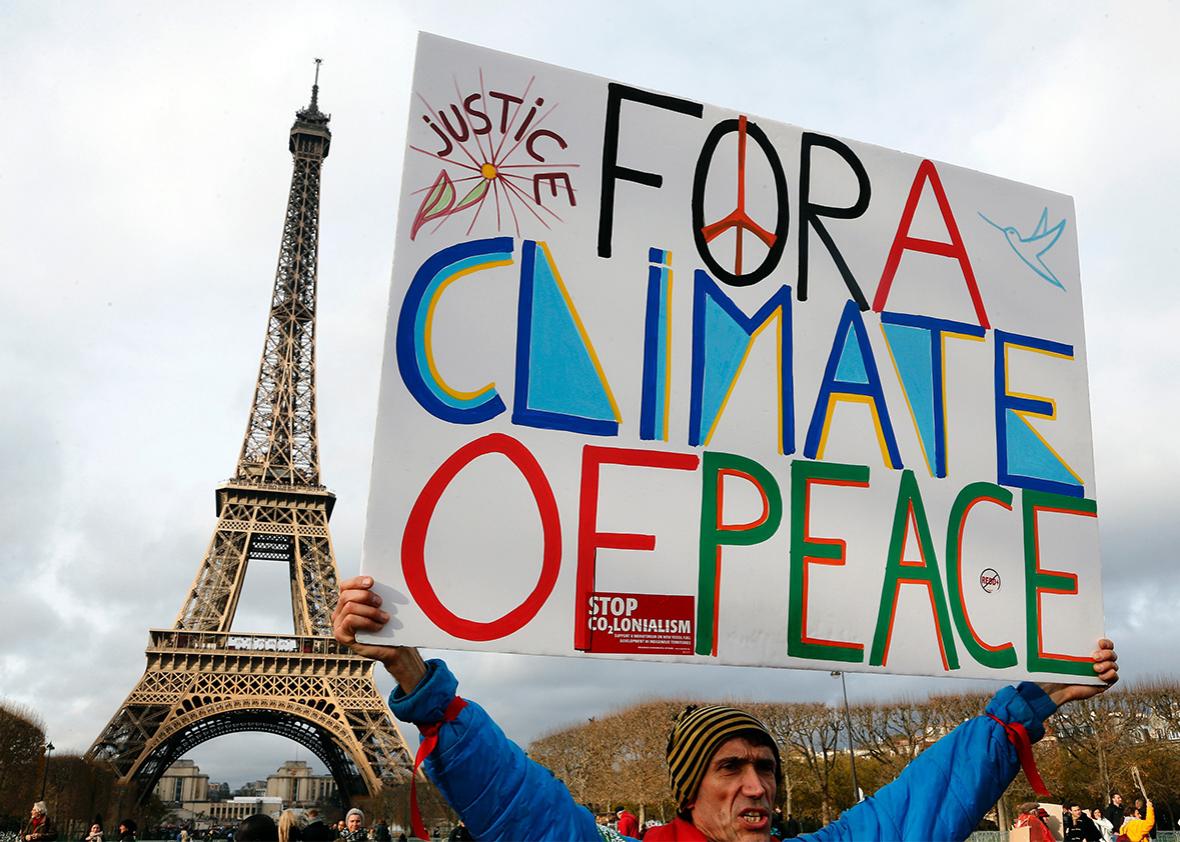The big criticism of the landmark Paris climate deal is its lack of enforcement mechanisms. If India keeps burning coal like crazy, it won’t face fines or sanctions. Nobody is going to invade Nigeria if it fails to lower emissions. What the critics don’t understand, however, is that this is a feature, not a bug. How else would you get 195 countries to sign off on it?
But that doesn’t mean that the Paris Agreement, announced Saturday, is worthless. Because the process it lays out—in which individual countries make emissions commitments and then reconvene every five years to measure progress and rich countries pledge $100 billion in aid to poorer countries—taps into a few forces that can be almost as powerful as the threat of punishment. These include: peer pressure, the desire to save face, the profit motive, and the dynamics of capitalism. And they should leave us feeling very optimistic about Paris’ chances of helping nations—and perhaps more importantly, companies—make serious progress on cutting emissions.
Now, some countries will likely do nothing, submitting a vague plan and then failing to follow up. And those with ambitious plans might not come close to meeting them. But many of the countries will, due to the pressures of internal and external politics. This is the way bureaucracies work. Countries make commitments. Then they devote human, financial, legislative, and government resources to meeting them. It will become somebody’s job—a ministry, a department, a task force—to work on lowering emissions. Bureaucratic pressures—the impulses to spend the budget, to show results, to keep your job, to not embarrass your government—may become a powerful spur to action. Meet your goals and you get rewarded and promoted.
We see this particularly in the corporate sector, where virtually every Fortune 500 company has an executive function tasked with dealing with sustainability: recycling, reducing water use, cutting emissions, bringing more renewable energy. They’re given budgets, benchmarks, and targets. And guess what? They take action. In October, 81 giant U.S. companies signed on to a pledge to cut emissions by as much as 50 percent. Others are pledging to become “net zero” entities, meaning they’ll offset all their emissions. To reach these stretch goals, they are purchasing renewable energy in huge gulps and rolling out fleets of vehicles powered by electricity and natural gas. Governments are getting into the act, too. San Francisco announced it has switched its fleet of nearly 2,000 vehicles that run on diesel to run on renewable diesel, slashing emissions by 50 percent.
While it may seem that many of these actions are primarily acts of public relations, the efforts to meet voluntary sustainability plans have real-world impacts. First, it is increasingly the case that lower-emissions solutions are less costly solutions. Companies may set out to save trees, but they wind up saving money. Every time Walmart puts a solar array on the roof of one of its stores, it is locking in energy savings for 15 or 20 years. And that gives sustainability efforts their own logic and impetus. Put solar arrays on five stores? That’s cool. Ikea has mounted solar on 41 of its U.S. stores. In places like Norway, where gas taxes are high and electric car owners get wonderful incentives, it may be cheaper to own a Tesla than an Audi. When companies switch to LED lightbulbs, they save a ton of money while reducing emissions sharply. In many instances, the more companies, governments, and people do to reduce emissions, the more they want to for purely financial reasons.
Effort toward reaching goals can often catalyze business investment. Tesla’s success has pushed a host of companies to invest further in making cars run more on electricity and less on gasoline. In the past week alone, Ford has announced it would invest $4.5 billion in vehicle electrification, and startup Faraday Future said it would build a fancy new electric car plant in Nevada.
The competition that ensues when multiple companies pursue a technology simultaneously can help reduce the cost and hasten its spread. That’s one of the key dynamics of capitalism that is often misunderstood. The more you do, the less it costs, and the more it makes sense for more people to do. As solar has gone from a cottage industry to a huge one, the cost of a solar module has plummeted dramatically.
As I’ve noted, we’re still missing the important, tough national and international standards that could help guarantee a lower-emissions future—harder caps on emissions, a price on carbon, and so on. But these are the sorts of things we can only get through changes in policy. The Paris Agreement may not offer much direct help in that regard. But by unleashing the dynamic I’ve described, it will help indirectly. As lower-emissions technologies become bigger businesses, as solar and wind and electrified vehicles employ more people and have more revenues, they will gain more lobbying power, more influence, and more political power. It’s already happening to a degree in certain U.S. states, like California, where the renewables crowd has far more political clout, than, say, the coal industry. All of which means that, even if countries fail to reach their goals, there will likely be more government incentives, tax breaks, and direct and indirect support for lower-emissions efforts.
Will the Paris Agreement help slow global warming? I have no idea. I am sure, however, that it will increase the global level of activities aimed at developing lower-emissions technologies. And I’m pretty sure that people will be surprised not by how much it costs to slash emissions but by how little.
